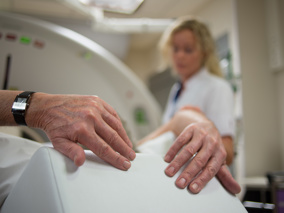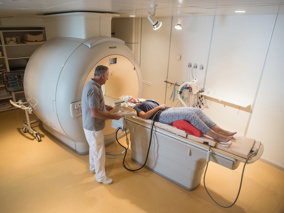Bladder cancer - muscle invasive
Bladder cancer has different stages of growth. Treatment depends on the stage of the tumor. If the tumor grows in the muscle layer of the bladder, we call it muscle invasive bladder cancer. If the tumor only grows in the cavity of the bladder and not in the muscle layer, it is called non-muscle invasive bladder cancer.
Read more about the symptoms and the examinations and treatments for muscle invasive bladder cancer on this page.
Learn more about muscle-invasive bladder cancer
Symptoms of muscle-invasive bladder cancer
Bladder cancer (usually) grows slowly. In the beginning it causes few or no complaints. The tumor is often discovered by chance. Blood in the urine is never normal. Go to the doctor immediately if you see that.
Especially in women, blood in the urine, along with recurrent urinary tract infections, can be a sign of bladder cancer. Then you must be referred to the hospital for diagnostic testing.
Symptoms of muscle-invasive bladder cancer at a later stage may include:
- Pelvic pain
- Pain in the side (flank)
- Weight loss
- Palpable swelling (mass) in the lower abdomen
Bladder cancer check-ups
After any cancer treatment, monitoring or follow-up is essential to minimize complications and to detect and treat recurrent cancers (recurrences) early. The first check-up appointment is three months after the treatment and you will arrange the follow-up check-ups with your urologist. Your urologist is also the point of contact for questions about the disease or related topics.
Aftercare
Bladder cancer can have a major impact on the lives of patients and their loved ones. In bladder cancer, patients often have to deal with specific problems, such as urinary problems or sexuality, in addition to the complaints that occur in cancer patients in general, such as fatigue, pain, limitations in social life and various psychological problems such as anxiety and insecurity. You can contact our Centre for Quality of Life for this.
Bladder cancer treatment
The treatment you receive depends on the type of tumour. Your health and fitness also play a role. The doctor will explain well in advance what is going to happen and you will have plenty of time to ask questions.
Below are the treatment options for each type of muscle-invasive bladder cancer:
Treatment for metastatic bladder cancer
In the case of metastases, the cancer is also in other organs or lymph nodes outside the pelvis. Then healing is usually no longer possible. Treatment is aimed at inhibiting the growth of the tumor and reducing symptoms (palliative care). The choice of palliative treatment depends on your complaints and wishes. The treatment is then intended to slow down the cancer as much as possible and to keep the symptoms under control.
Waiting
We want to inform you as well as possible about the waiting time per condition. We do this based on a prognosis of the current waiting list. The waiting time can vary from patient to patient for various reasons. Your attending physician will give you more information during your outpatient consultation.
-
9 days
First appointment
This is approximately how long it will take until you have your first appointment
-
8 days
Rapid diagnostics
This is approximately how long it will take before you can start rapid diagnostics at the NKI
-
16 days
Second opinion
This is approximately how long it will take before you come in for a second opinion at the NKI
 nl
nl




